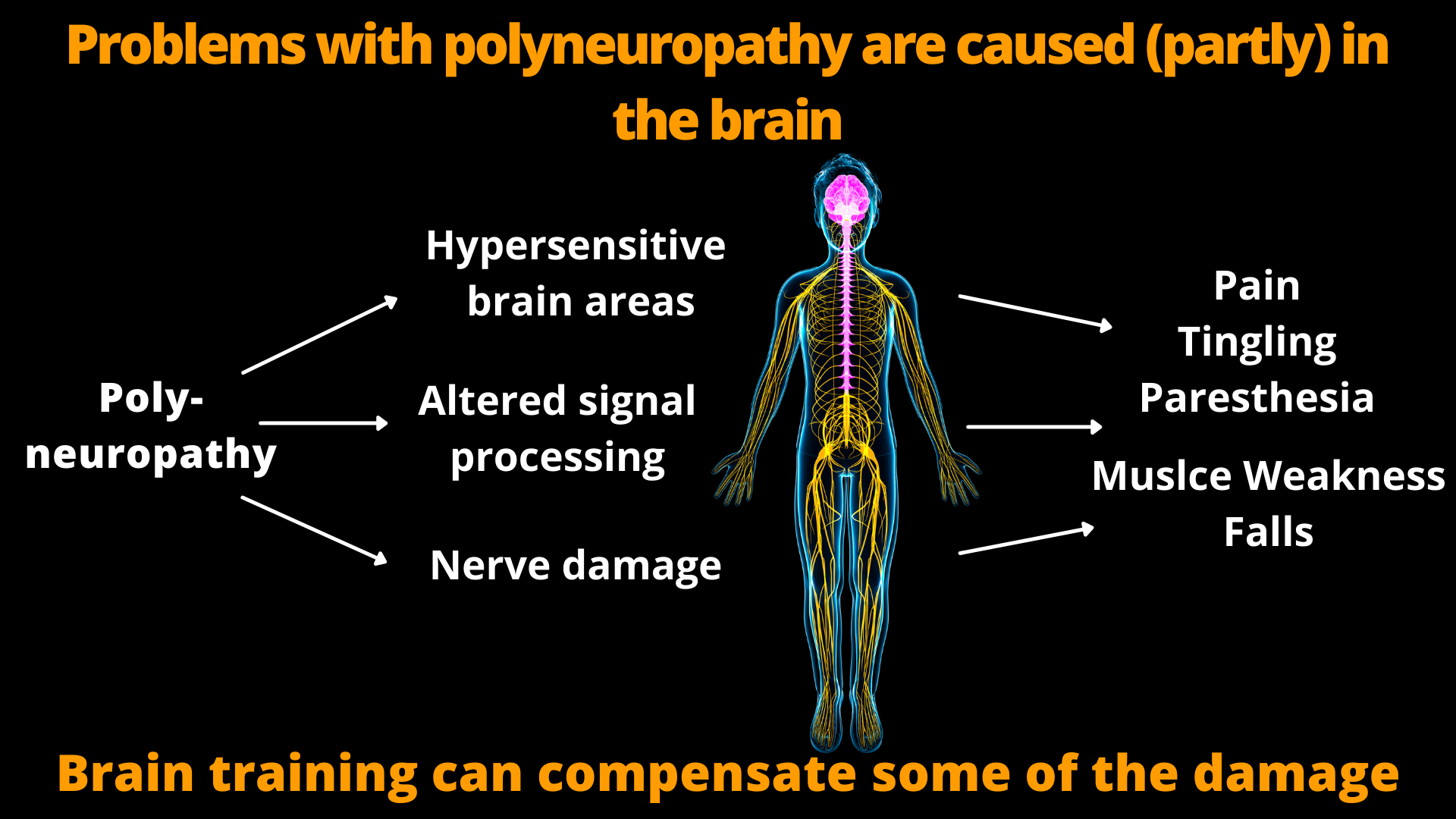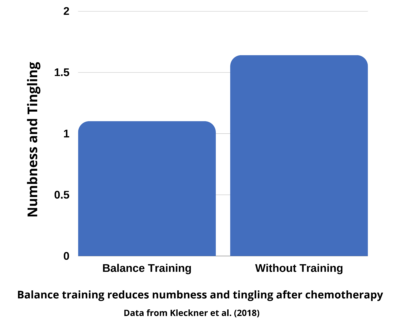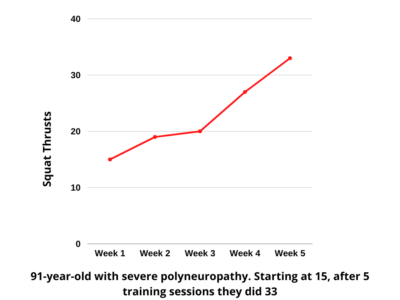Physiotherapy is indispensable
Physiotherapy is indispensable in polyneuropathy in order to remain mobile and active despite the disease and to have as little pain as possible. In this article you will find all the effective methods and instructions on how to help yourself with it.
The different methods summarized
These methods are used in physiotherapy for polyneuropathy:
- Exercise therapy:
Balance training to walk safely and remain mobile despite polyneuropathy. In addition, balance training often helps with symptoms such as pain and discomfort.
Strength training maintains the strength of the muscles and the stability of the bones. Thus, it keeps one fit enough for everyday life and protects against falls and injuries.
Vibration training reduces pain and discomfort. - Methods to keep the muscles loose and flexible:
Massage often helps with the pain of polyneuropathy by relaxing overworked muscles.
Stretching prevents the muscles from shortening and also helps against pain - Electrotherapy:
High tone therapy can stimulate regeneration of the nerves in certain forms of polyneuropathy and thereby help against the symptoms.
TENS (transcutaneous nerve stimulation) can help provide short-term pain relief.

1. Balance training
The most important method of physiotherapy to remain mobile despite polyneuropathy is balance training.
To maintain balance, you need to feel exactly what position your body is in and constantly shift your weight and adjust muscle tension. For this, you need a good feeling for your own body and good movement control. The more you practice your balance, the better you get at feeling what position your body parts are in and controlling their movements.
This method has been used for a long time and has proven successful with both competitive athletes and seniors. Training your balance improves your coordination and thus makes movements easier, because you learn to use your strength better and thus strain your muscles less. In addition, balance training reduces the risk of falls and injuries in people of all fitness levels - this works for everyone, from high-performing athletes to nursing home residents.
Therefore, for those who suffer from polyneuropathy, balance training lowers the risk of falling and improves their ability to walk safely and be active despite the condition.



Bewegung bei Polyneuropathie
You can find exercises here:
Exercise for polyneuropathy
Pain in polyneuropathy and what you can do about it
Balance training seems to help against pain
However, balance training has another surprising positive effect: it often helps with pain.
I myself have already seen some patients' pain and discomfort improve with balance training. Also in a study from the University of Freiburg it was observed that patients who developed polyneuropathy due to chemotherapy had less pain and discomfort due to balance training.
However, this effect does not seem to occur in all patients. However, the reason for this is not yet clear.

2. strength training in physiotherapy for polyneuropathy.
Strength training and muscle building is essential as part of physical therapy and physiotherapy for polyneuropathy for several reasons:
1. Strength in one place can compensates for weaknesses elsewhere.
Those who train their muscles despite polyneuropathy can often maintain their strength and fitness despite polyneuropathy. For example, those who have little strength in their lower legs due to polyneuropathy can still exercise their thighs and thereby compensate for the deficits, at least in part. Tasks that can no longer be performed by muscles in one place are then performed by other muscles. For example, even with very weak calves, you can still run stairs if the muscles in your thighs are strong.
2. strength training strengthens not only the muscles but also the bones.
When you do strength training, especially with heavy weights, it also causes a training effect on the bones. This is because the bones have to withstand and transmit the force applied by the muscles. This makes the bones denser and more resistant to fracture. By the way, you don't necessarily have to train on heavy weight machines to do this. According to a study in the international journal of osteoporosis (Osteoporosis international), free weight exercises (so using only a weight like a dumbell instead of a machine) are even more effective for building bone mass than training on machines (You can read the study here: Shojaa et al. 2020).
3. strength training helps grow more nerve endings and activate more muscle fibers.
To activate a muscle, signals are sent from the nerves to the muscle fibers, which stimulate the muscle fibers to contract. Your nerves can never activate all the fibres of the same muscles at the same time. However, it is possible to train how many fibers can be activated simultaneously. If you do strength training with high resistance, new nerve endings that can activate more fibers grow into the muscle as a result. This improves the ability to have many muscle fibers working at the same time, and therefore also improves strength. Especially if you lose your muscle strength due to polyneuropathy, such training is important because it allows more muscle fibers to work despite the disease. It is thus possible to maintain strength for a longer period of time despite the polyneuropathy than if no training would be done.
4. even at an advanced age and with severe polyneuropathy, it is still possible to build strength
Many people assume they can't become stronger strength or grow their muscles at all because of polyneuropathy or age. In my practice, I regularly work with people beyond 80 and 90 who have polyneuropathy. Through targeted training, an increase in strength is almost always possible. If the polyneuropathy paralyzes one part of the body, it is usually still possible to increase strength elsewhere. By the way, this is not only my own observation, but has also been observed in scientific studies. (A review paper on this can be found here: Tofthagen et al. 2012)
In this illustration, you can see how a patient of mine, over 90 years old and with severe polyneuropathy, managed to do more and more squats after just a few training sessions. The effect in this case, by the way, was very lasting. Today, two years later, he manages to do more than 50 squats.
Detailed information on exercise for polyneuropathy can be found here: Sport and polyneuropathy
Strength exercises specifically for polyneuropathy can be found here: Exercises for polyneuropathy

Exercise your hands and fingers with therapy clay and peas
One method that is used very often is kneading clay or peas to maintain the strength of the fingers. In particular, kneading therapeutic clay seems to be very suitable as a strengthening exercise for the fingers.
In order to maintain the fine motor skills of the fingers, they are specially trained in physiotherapy. In addition, patients can do as many fine motor skill demanding things as possible even in everyday life in order to maintain these skills for as long as possible. This is because skills that are practiced frequently can probably still be performed even as polyneuropathy progresses.
3. stretching of muscles in physiotherapy for polyneuropathy.
One goal of physiotherapy for polyneuropathy is to keep the muscles in a normal, relaxed state and prevent muscle tightness from occuring. You also want to maintain mobility as much as possible. To achieve this, stretching is very important.
In addition, stretching exercises can help reduce pain. This is because the pain associated with polyneuropathy is not always due to nerve damage alone. Often you also have pain because the muscles are hardened, because you are constantly overloaded due to the disease. In such cases, stretching exercises can often significantly improve pain.
You can find out more information about pain management in polyneuropathy here: Polyneuropathy pain and what you can do about it
Can stretching heal nerve damage in polyneuropathy?
There is the assumption that stretches that specifically stretch the nerves may help improve or regenerate polyneuropathy. This is suspected in particular because there are animal experiments in which the test animals were administered poisons that trigger polyneuropathy and at the same time such stretches were performed. As a result, the experimental animals whose nerves were stretched had less severe polyneuropathy. However, it is not sure whether this effect can also be achieved by stretching in people with polyneuropathy. I have tried such stretches myself with some patients and could not see any such effect. I therefore assume that physiotherapeutic stretching exercises only have a positive effect on the muscles and not directly on the nerves.
4. massage for polyneuropathy
Like stretching, massage can be helpful for polyneuropathy, not by curing the disease, but by alleviating its effect on the muscles. Massage cannot heal the nerves. However, it is possible to use this physiotherapeutic method to relax the muscles and thereby reduce the pain. In my own experience, cramped muscles very often play a role in the development of pain in polyneuropathy. This is because the disease causes muscle strength to decrease and movement patterns to change. This often results in chronic overuse of the muscles. These react to this by hardening. These muslce hardenings can cause tremendous pain. Therefore, in polyneuropathy, it is usually not possible to distinguish whether the pain is due to nerve damage or due to cramped muscles. So, basically everyone with polyneuropathy sould try out whether a treatment of the muscles can reduce the pain.
More info and instructions on self-massage for polyneuropathy can be found here:
Pain in polyneuropathy and what you can do about it
Massage for polyneuropathy
Massage bei Polyneuropathie
5. vibration training in physiotherapy for polyneuropathy
Vibration training is considered one of the most effective methods of physiotherapy for polyneuropathy. It seems to be especially helpful in patients suffering from pain due to polyneuropathy. Some studies show improvements in pain and discomfort due to polyneuropathy after vibration exercise.
Kessler et al. (2020) and several other research groups observed improvements in symptoms in patients with diabetic polyneuropathy. In addition, vibration training has (small) effects on muscle strength and balance and improves walking.
Streckmann et al. (2019) compared vibration training and balance training in patients with polyneuropathy after chemotherapy. They found that vibration training was more likely to help with pain, while balance training was more likely to help with other symptoms of polyneuropathy. Accordingly, it makes sense to do both at the same time.
It is important not to start vibration training too intensively and especially not to train for too long at a time. If you immediately perform a long workout with strong vibration, you run the risk of overloading yourself. This can often lead to muscle tightness and pain all over the body. At the very beginning, you should only stand on the vibration plate for one minute and then take a long break.
Even if you are already better trained, it makes most sense to alternate one minute of vibration and one minute of rest. 5 sets of this seem to be enough.
By the way, as far as I know, it has not yet been clarified exactly how strong the vibration should be. My personal guess is that high vibration levels should be set on commercially available devices.
Exercises on the vibration plate
In principle, it seems to be sufficient to just stand on the vibration plate, or even sit on a chair in front of it and only place your feet on the plate. The vibration then already affects the legs and stimulates the nerves. However, you can also use this time more effectively by doing some additional exercises. Here is a selection of exercises in different levels of difficulty:
- Standing on the vibration plate with your eyes closed.
This way you train your balance and body awareness at the same time as doing vibration training. - Squats on the vibration plate
This way you train the strength of your legs at the same time - Do calf raises on the vibtation plate.
This way you additionally train the strength of your calves. - If you have very big problems with pain or balance you can also just sit on a chair in front of the vibration device and put your feet on the device.
Vibration training for the hands and arms
By the way, you can not only stand on a vibration plate. You can also use it to specifically vibrate your arms if you have problems in your hands due to polyneuropathy.
To do this, get on your knees directly in front of the plate and place your hands on the plate.
You can additionally bend and stretch your arms, thereby moving your upper body up and down (similar to push-ups). This way you train the strength of your arms at the same time.
6. electrotherapy in physiotherapy for polyneuropathy
Another method used in physiotherapy for polyneuropathy is electrotherapy. In this process, the nerves are stimulated with electrical stimuli. There are two main methods for doing this:
1. TENS (Transcutaneous Nerve Stimulation)
This method is mainly suitable to relieve the acute pain. This treatment directly targets the nerves and has an analgesic effect. Immediately after treatment with TENS, people often feel less pain. However, this effect usually disappears after a few hours. Thus, TENS does not result in long-term improvement.
2. high tone therapy
High tone therapy uses special electric fields where current frequency and strength are varied. (The exact physical processes are beyond the scope of this article and can be read here ). More important is the question of effectiveness. There are studies that found a small positive effect when high tone therapy was used daily for several months. However, most studies have been performed only in diabetic polyneuropathy. To my knowledge there are very few studies with other forms of polyneuropathy. My own patients, who have tried the method, mostly tell me that the high tone therapy has not brought them any lasting improvement. In my opinion we do not yet know for sure how effective high tone therapy actually is in polyneuropathy.
Individual advice
If you would like to discuss your individual situation and treatment and training options with me contact me for an individual consultation
Bitzer Sporttherapie
M.A. Sports Science (Universities of Freiburg, Stuttgart and Granada)
B.A. Sports Therapy (University of Freiburg)
Sports therapist for internal medicine and orthopedics (DVGS)
Email: Bitzer.Sporttherapie@gmail.com
